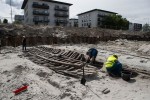 Construction workers building a new apartment complex in Tallinn, the capital of Estonia, have discovered the remains of two medieval ships. Workers were digging the foundations on May 22nd when the bucket of the excavator encountered large pieces of very old wood. The construction company stopped work and alerted the National Heritage Board (NHB) who sent experts to examine the find. On May 26th the crew unearthed another shipwreck at the other end of the construction site. The area was then scanned with ground-penetrating radar and a third likely shipwreck was located.
Construction workers building a new apartment complex in Tallinn, the capital of Estonia, have discovered the remains of two medieval ships. Workers were digging the foundations on May 22nd when the bucket of the excavator encountered large pieces of very old wood. The construction company stopped work and alerted the National Heritage Board (NHB) who sent experts to examine the find. On May 26th the crew unearthed another shipwreck at the other end of the construction site. The area was then scanned with ground-penetrating radar and a third likely shipwreck was located.
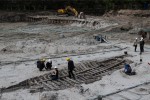 Construction has been suspended and this week NHB archaeologists began excavating the first shipwreck. The bones of the ship are now clearly visible and can be seen by members of the public who care to glance down. It’s 15 meters (50 feet) long, four meters (13 feet) wide and 1.5 meters (five feet) deep at the deepest point. Archaeologists tentatively date it to between the 14th to 17th century.
Construction has been suspended and this week NHB archaeologists began excavating the first shipwreck. The bones of the ship are now clearly visible and can be seen by members of the public who care to glance down. It’s 15 meters (50 feet) long, four meters (13 feet) wide and 1.5 meters (five feet) deep at the deepest point. Archaeologists tentatively date it to between the 14th to 17th century.
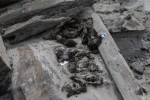 It was found close to four meters below modern ground level, in the sediments of what was once the seabed. Although the site is 200 meters (ca. 220 yards) from the water today, for centuries it was a port. In the late 1930s the area was infilled with ash and household refuse. It’s not clear if the ships sank there are were gradually buried over time by siltification, or if they were deliberately sunk after reaching the end of their natural lives. They were certainly stripped of all usable parts — metal fittings, rigging and masts — before being abandoned.
It was found close to four meters below modern ground level, in the sediments of what was once the seabed. Although the site is 200 meters (ca. 220 yards) from the water today, for centuries it was a port. In the late 1930s the area was infilled with ash and household refuse. It’s not clear if the ships sank there are were gradually buried over time by siltification, or if they were deliberately sunk after reaching the end of their natural lives. They were certainly stripped of all usable parts — metal fittings, rigging and masts — before being abandoned.
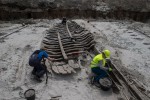 Estonian Maritime Museum archeologist Vello Mässi believes it was a short-haul transport vessel, used to move cargo from the shore to the large ships in the deeper waters of the bay. Archaeologists are excited to have the opportunity to study such old ships in detail. This is the first time multiple historic wrecks have been found so close together. The last time the remains of a wreck were found in Tallinn was 2009 when road construction unearthed a 13th century ship. They are keen to examine these finds to learn about how they were built and when and what wood was used.
Estonian Maritime Museum archeologist Vello Mässi believes it was a short-haul transport vessel, used to move cargo from the shore to the large ships in the deeper waters of the bay. Archaeologists are excited to have the opportunity to study such old ships in detail. This is the first time multiple historic wrecks have been found so close together. The last time the remains of a wreck were found in Tallinn was 2009 when road construction unearthed a 13th century ship. They are keen to examine these finds to learn about how they were built and when and what wood was used.
Archaeologist Priit Lahi admits the find was an important discovery to shed light on possible shipbuilding methods from centuries before.
“At the time, shipbuilders used their own methods — it wasn’t very scientific. There weren’t project drawings like we have today,” he told the Associated Press.
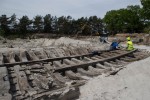 Excavations are scheduled to continue at least through July 8th. While the developers building the apartment complex have expressed interest in display the find in some way, construction won’t be delayed much longer or halted. It would be too expensive and time-consuming to keep the wrecks in situ, so they will be raised, documented and studied before their ultimate disposition is decided. They may be reburied in sand at another location for their own preservation, which would allow future examination of the wrecks by scholars and make them easy to retrieve for future conservation and display.
Excavations are scheduled to continue at least through July 8th. While the developers building the apartment complex have expressed interest in display the find in some way, construction won’t be delayed much longer or halted. It would be too expensive and time-consuming to keep the wrecks in situ, so they will be raised, documented and studied before their ultimate disposition is decided. They may be reburied in sand at another location for their own preservation, which would allow future examination of the wrecks by scholars and make them easy to retrieve for future conservation and display.
For more pictures of the ship and site, check out the photo galleries here and here.
WOW ! This is indeed a fantastic discovery, and so much left of it for conservation. Albeit finances can be raised to do the work.
interesting comment: “At the time, shipbuilders used their own methods – it wasn’t very scientific – there weren’t project drawings…” .
It didn’t need to be “scientific”, in that the shipbuilders knew, for ships of that size, exactly what they were doing and how to build vessels using the wood and the technology they had at hand. They didn’t need drawings to build the vessels. (I’m reluctant to call them “ships” if they turn out to be lighters, used for ferrying cargo from ship to shore). They did use their own methods, developed over the centuries, because those methods worked.
We look at wood and see…wood. They looked at wood and saw a widely varied construction material that could be used in many different ways depending on the type of wood it was, where it grew and in what kind of environment, when it was harvested, from where in the tree it came, how it was seasoned, and so forth.
The American writer Eric Sloane’s 1965 book “A Reverence for Wood”, in my opinion, is the best general book on this topic and how it was understood in the pre-industrial age by those who made things.
Really interesting, as usual. I check this site daily and am never disappointed! :boogie:
I always fantasized about finding a treasure in the back garden when I was little. Now this is a dream come true!
Hardly medieval.
*Fascinated and frustrated.* I wish I could better understand what the pictures show. Is it a keel that’s bowing the ribs into a soft “w,” or is that the side of the vessel and some buckle or feature in the staves warped the ribs, with the keel laying alongside? Or is there even a keel at all?
Estonia and Latvia always seem to find some of the neatest things. Thank you for snagging, translating, and showing the information to us!
In Estonia, it probably was.
Its in my back garden! I live in Liivaoja. I had a look in the rubble left outside the site (a pile has been dumped outside the restricted zone) and I found a plate with a nazi insignia on it so the household rubble part is definitely correct, lots of broken porcelain and glass are easily spotted, its an exiting find to have in the back yard.